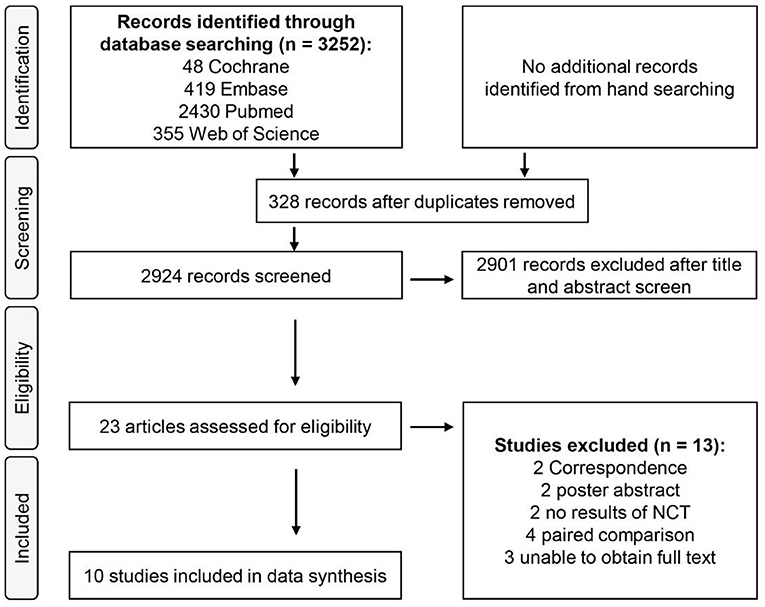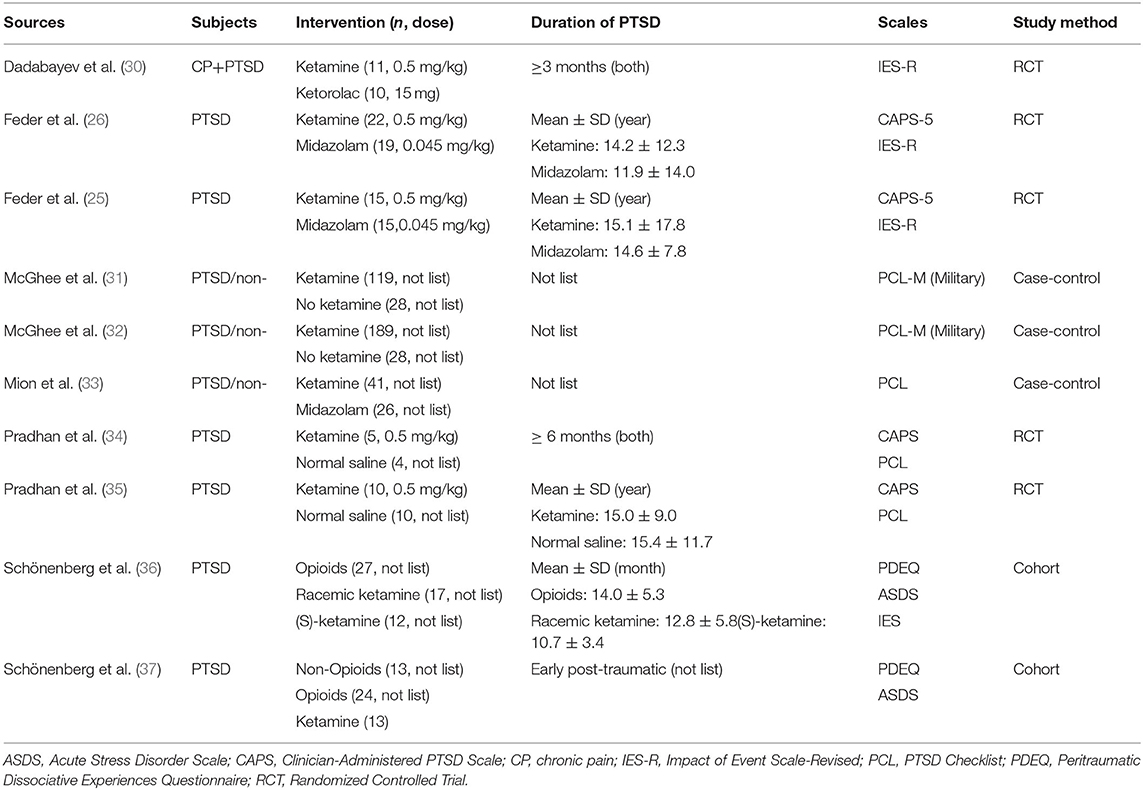- 1Institute for Biomedical Sciences of Pain, Tangdu Hospital, Fourth Military Medical University, Xi'an, China
- 2Department of Anaesthesiology, Tangdu Hospital, Fourth Military Medical University, Xi'an, China
- 3Department of Anaesthesiology, Key Laboratory of Carcinogenesis and Translational Research (Ministry of Education/Beijing), Peking University Cancer Hospital and Institute, Beijing, China
- 4Tangdu Hospital, Fourth Military Medical University, Xi'an, China
- 5Department of Physiology and Pathophysiology, National Key Discipline of Cell Biology, Fourth Military Medical University, Xi'an, China
- 6State Key Laboratory of Cancer Biology and National Clinical Research Center for Digestive Diseases, Xijing Hospital of Digestive Diseases, Fourth Military Medical University, Xi'an, China
Background: Post-traumatic stress disorder (PTSD) is a serious stress-related disorder caused by traumatic experiences. However, identifying a key therapy that can be used for PTSD treatment remains difficult. Ketamine, a well-known dissociative anesthetic, is considered safe to be used in anesthesia, pain management, and antidepressant actions since 1970. At present, it is still controversial whether PTSD can be treated with ketamine. The authors performed a meta-analysis to determine whether the use of perioperative ketamine lowers the incidence of PTSD.
Methods: Cochrane Central Register of Controlled Trials, Embase, PubMed, and Web of Science were searched to examine the use of ketamine for the treatment of PTSD among soldiers with combating experience. Studies were included if they were randomized placebo-controlled, case-control, and cohort studies. The primary outcome was the incidence of PTSD in the later stage of the wounded or burn soldiers. The secondary outcome was the influence of ketamine on PTSD-scale scores for early and chronic PTSD, respectively.
Results: Our search yielded a total of three studies (n = 503 patients) comparing the use of ketamine (n = 349) to control (n = 154). The available evidence showed no significant difference in the incidence of PTSD between combatant soldiers on the battlefield with or without ketamine treatment (risk ratio = 0.81, 95% CI, 0.63–1.04; P = 0.10). In 65 patients from three trials, ketamine was not only ineffective in treating early PTSD but also lead to exacerbation of the disease (risk ratio = 2.45, 95% CI, 1.33–3.58; P < 0.001). However, in 91 patients from the other three trials, ketamine is effective in treating chronic PTSD (risk ratio = −3.66, 95% CI, −7.05 to −0.27; P = 0.03).
Conclusion: Ketamine was not effective on lower the PTSD incidence for soldiers on the battlefield, nor on the PTSD-scale scores in early PTSD patients. However, it may improve the PTSD-scale scores for chronic conditions.
Systematic Review Registration: https://www.crd.york.ac.uk/prospero/display_record.php?ID=CRD42021255516, PROSPERO, identifier: CRD42021255516.
Introduction
Posttraumatic stress disorder (PTSD), defined as a “trauma- and stressor-related disorder,” is a common mental illness (1). The lifetime prevalence of PTSD ranges from 1.3 to 12.2%, and the 1-year prevalence is 0.2–3.8%. The prevalence varies according to psychological and biological factors such as social background, country of residence, endocrine, and genrtic factors (2). PTSD is also associated with suicidal behavior (3), but the authenticity of the relationship remains unclear. Patients with PTSD may have repeated recall of the traumatic experience, avoidance of traumatic situations, hyperarousal, depression, anxiety, substance use disorders, pain, and other symptoms (4). The existing treatments of PTSD include psychotherapy, medication, and innovative interventions such as acupuncture, transcranial magnetic stimulation, and stellate ganglion block (5–8). Howerer, the efficacy of treatments variesdue to the multiplicity and interdependence of biological features (9–14) and complicated pathogenesis, and thus there is a pressing need for research on the pathogenesis and treatment of PTSD.
Ketamine, an N-methyl-D-aspartate (NMDA) receptor antagonist (15, 16), is widely used as a general anesthetic and offers promising perspectives for activating several neurotransmitter pathways in the brain (17–20). Ketamine also has potent analgesic properties (21, 22), anti-inflammatory effects (23), and antidepressant effects (24). In recent years, studies suggest that intravenous ketamine (a single or repeated dose) can quickly reduce the severity of PTSD symptoms in chronic cases [14.6 (25.9), years (SD)] (25, 26). However, the molecular mechanisms involved in the clinical therapeutic effects of ketamine remain unclear and need further exploration.
In the present study, we performed a meta-analysis and systematic review on the use of ketamine and its effects on PTSD.
Materials and Methods
Search Strategy and Inclusion Criteria
This meta-analysis and systematic review were registered with PROSPERO (CRD42021255516) and followed the preferred reporting project for systematic reviews and meta-analysis (PRISMA) recommendations (27).
A detailed systematic review of the following databases was performed from inception to 23 May 2021: Cochrane Central Register of Controlled Trials, Embase, PubMed, and Web of Science. The following search terms were used for PubMed: (“ketamine” OR “Ketalar” OR “Calipsol” OR “Kalipsol”) AND (“PTSD” OR “posttraumatic stress disorder” OR “posttraumatic stress symptoms” OR “acute stress disorder”). Randomized controlled trials (RCTs), case-control studies, and cohort studies were included. Both dichotomous and continuous variables were separately included.
Data Extraction and Quality Assessment
After preliminary screening of the abstract, if found to be suitable, the full text of this article would be further studied. Two authors (Rui and Guofang) independently reviewed all search results based on inclusion and exclusion criteria. The divergent research items were determined by an independent researcher (Kun). All included trials were reviewed by authors to ensure that they met the eligibility criteria. The risk of bias was assessed using Review Manager 5.3. This evaluation included assessment of random sequence generation, allocation concealment, blinding of participants and personnel, blinding of outcome assessment, incomplete outcome data, selective reporting, and other sources of bias. Disagreements in the process were resolved through discussion until a consensus was reached.
The results from RCT, case-control, and cohort studies related to the terms “Ketamine” and “PTSD” were included in this meta-analysis. We excluded correspondences, poster abstracts, texts with no NCT results (National ClinicalTrial.gov), paired comparisons, and manuscripts for which the full text could not be obtained.
Two investigators (Rui and Guofang) independently screened the literature based on the above inclusion and exclusion criteria. By revisiting the original text and performing any appropriate calculations or conversions, any discrepancies found were resolved. Intuitively extracted data included the first author, publication time, participants, study interventions, types of outcomes, reasons for exclusion, study control, and duration of follow-up.
Data Analysis
The primary outcomes were the effects of ketamine on the occurrence of PTSD in the later stage of the wounded or burn soldiers on the battlefield. The second outcome was the effect of ketamine on patients with diagnosed early PTSD (usually 1–3 months after traumatic events) andchronic (more than 3 months) PTSD based on multiple psychological assessment scales. The Mantel-Haenszel (M-H) method was used to pool dichotomous data and to compute the risk ratio (RR) with its corresponding 95% confidence interval (CI). The inverse variance (IV) method was used to pool continuous data and to calculate the standardized mean difference with a 95% CI. Random effects models were used with or without apparent heterogeneity based on I2 > 50% compared to the fixed effects model (I2 < 50%) (28, 29). Sensitivity analysis was performed to assess the stability of the meta-analysis. P < 0.05 was considered statistically significant. Review Manager software (RevMan, version 5.3.5. Copenhagen: The Nordic Cochrane Center, The Cochrane Collaboration, 2014) was used for this study.
Results
Study Characteristics
The selection process is summarized in Figure 1. The characteristics of the trials are presented in Table 1. An initial search identified 3,252 articles, including 328 duplicates. Thus, 2,924 articles were screened according to the previously formulated retrieval strategies. After the exclusion of 2,901 articles based on title or abstract, 23 full-text articles were reviewed and assessed for eligibility. Of these, 13 were further excluded because two were correspondences without chart data (38, 39), two were poster abstracts without chart data (40, 41), two were NCTs finished without posted results [NCT02398136, NCT02655692], three were abstracts without available full texts (42–44), and four were paired comparisons, which were not considered in this meta-analysis (Figure 1) (45–48). Finally, 10 studies that met (five RCT studies, three case-control studies, and two cohort studies) our predetermined inclusion criteria were included in this study. The results of the risk of bias assessment are shown in Figure 2. A total of 10 studies reported the effects of ketamine on the occurrence of PTSD after battlefield rescue or in burned patients (31–33) as well as symptom changes in early PTSD patients with a dose of ketamine (0.5 mg/kg) (30, 34, 37) and the same dose for chronic PTSD patients (25, 26, 35).
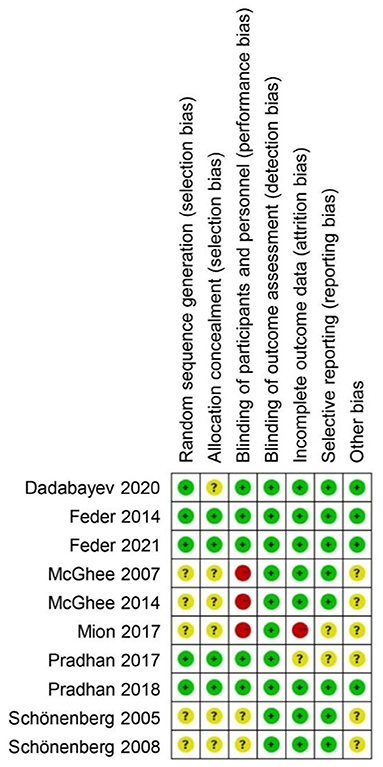
Figure 2. Summary table illustrating risk of bias results for included studies. Green circle, low risk; yellow circle, some concerns; red circle, high risk.
The 10 studies involved a total of 705 patients and were allocated to eligible study groups (Figure 1). Of these, a total of 442 patients were assigned to ketamine or (S)-ketamine, and 263 were assigned to the control (i.e., ketorolac, midazolam, normal saline, and opioid or placebo, Table 1). Patients in five studies (Table 1) (31–35) received a diagnosis of PTSD assessed with a PTSD checklist (PCL) (49). Patients in four studies (Table 1) (25, 26, 34, 35) received the Clinician-Administered PTSD Scale (CAPS) (50). Patients in 4 studies (Table 1) (25, 26, 30, 35) received the Impact of Event Scale-Revised (IES-R) (51). Patients in two studies (Table 1) (36, 37) were assessed based on the Acute Stress Disorder Scale (ASDS) (52).
Ketamine for the Multivariate Effect of PTSD
Three studies (31–33) including 503 patients (ketamine 349, control 154) in the battlefield reported no significant reduction in PTSD prevalence (Figure 3) with ketamine (no dose list) based on a risk ratio (95% CI) of 0.86 (0.61–1.20), p = 0.38, I2 = 52% compared with the control.

Figure 3. Forest plot of the prevalence of PTSD in battlefield analgesia by ketamine. M–H, Mantel–Haenszel.
Three studies (30, 34, 37) including 67 patients (ketamine 29, control 38) reported scores that changed in early PTSD based on ASDS (four subscales, including dissociation, reexperiencing, avoidance and hyperarousal) (37), IES-R, PCL, and CAPS scales (Figure 4). Taken together, compared with the control, ketamine (0.5 mg/kg) aggravated PTSD symptoms (Figure 4) by a mean difference (95% CI) of 2.45 (1.33–3.58), p < 0.001, I2 = 0%. Subgroup analysis for each time point suggested that 1 day after management (ketamine 16, control 14), ketamine (0.5 mg/kg) showed no significance of aggravation in PTSD symptoms by a mean difference (95% CI) of −2.50 (−8.26 to 3.27), p = 0.40, I2 = 0%; <3 days after management (ketamine 13, control 24), ketamine aggravated PTSD symptoms by a mean difference (95% CI) of 2.68 (1.53–3.83), p < 0.001, I2 = 0%; 1 week after management (ketamine 10, control 9), ketamine (0.5 mg/kg) showed no significance of aggravation in PTSD symptoms by a mean difference (95% CI) of −5.45 (−24.80 to 13.90), p = 0.58. Including one study without infusion time [49], ketamine aggravated PTSD symptoms (Supplementary Figure 1) based on a mean difference (95% CI) of 1.72 (0.95–2.48), p < 0.001, I2 = 0%.
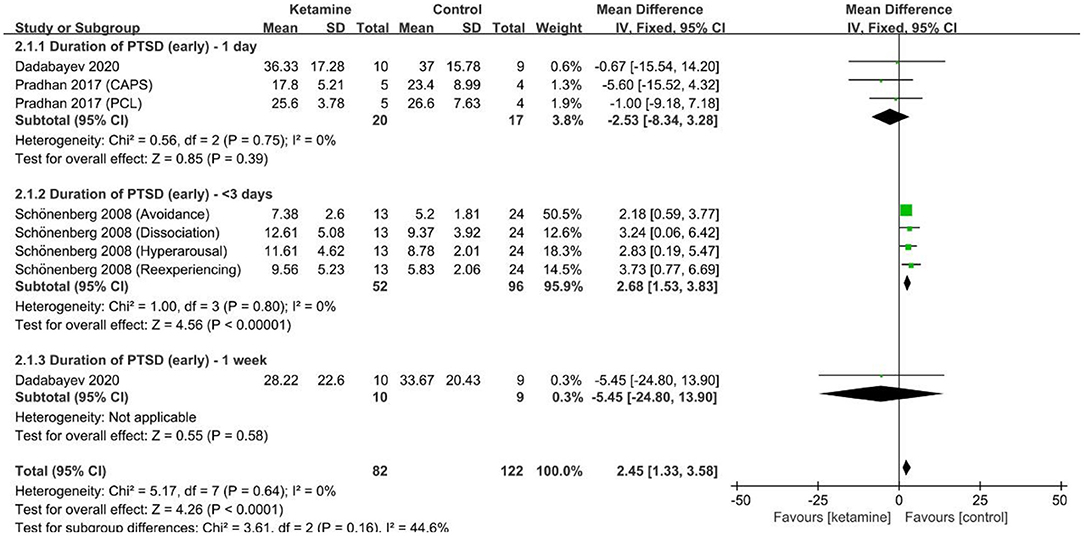
Figure 4. PTSD-scale scores of short duration (months) by ketamine administration (ketamine vs. control). CAPS, Clinician-Administered PTSD Scale; PCL, PTSD Checklist; IV, inverse variance; SD, standard deviation.
Our third coprimary outcome, including 91 patients (ketamine 47, control 44) (25, 26, 35), reported that scores changed over a long duration of PTSD (years) according to the CAPS, IES-R and PCL scales (Figure 5). Compared with the control, ketamine (0.5 mg/kg) relieved PTSD symptoms (Figure 5) by a mean difference (95% CI) of −3.66 (−7.05 to −0.27), p = 0.03, I2 = 35%. Subgroup analysis for each time point suggested that 1 day after management (ketamine 47, control 44), ketamine (0.5 mg/kg) showed no significance of relief in PTSD symptoms by a mean difference (95% CI) of −0.19 (−3.34 to 2.96), p = 0.91, I2 = 0%; 1 week after management (ketamine 19, control 15), ketamine (0.5 mg/kg) relieved PTSD symptoms by a mean difference (95% CI) of −11.02 (−19.61 to −2.43), p = 0.01, I2 = 0%; 2 weeks after management (ketamine 15, control 15), ketamine (0.5 mg/kg) relieved PTSD symptoms by a mean difference (95% CI) of −8.55 (−14.41 to −2.69), p = 0.004, I2 = 0%.
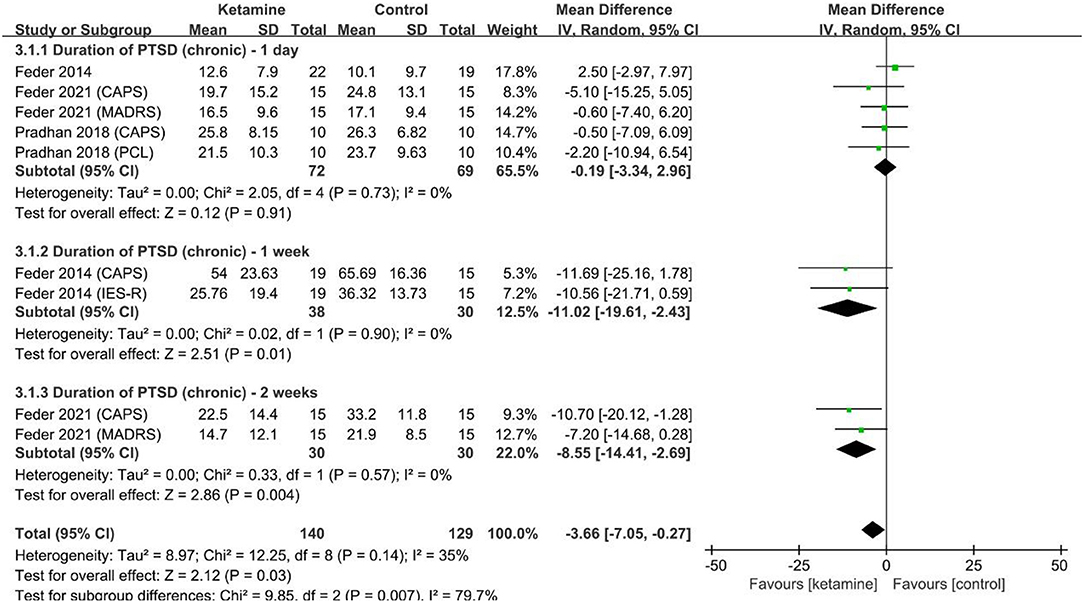
Figure 5. PTSD-scale scores of long duration (chronic, years) patients by ketamine. administration (ketamine vs. control). CAPS, Clinician-Administered PTSD Scale; MADPS, Montgomery-Asberg Depression Rating Scale; IES-R, Impact of Event Scale–Revised score; PCL, PTSD Checklist; IV, inverse variance; SD, standard deviation.
Discussion
In the present study, ketamine had no effect on the development of PTSD for injured soldiers (e.g., firearm, explosive, burn, or accident) on battlefields. The symptoms were aggravated in the patients who had been diagnosed with early PTSD after the administration of ketamine. However, the symptoms were ameliorated in patients with chronic PTSDafter ketamine treatment. The results indicate that ketamine treatment was not related to the development of PTSD but was associated with the disease duration in PTSD patients.
It is traditionally believed that ketamine administration is associated with an increased incidence of PTSD. However, in our study, no significant difference was noted between the development of PTSD and ketamine treatment in injured soldiers. Although the explanation for the difference in the results is unclear, our findings are also supported by Mion et al. (33) given that ketamine did not increase the risk of PTSD. The use of ketamine during a stressful event may reduce the preventive effect, but have no effect on the subsequent development of PTSD (31, 33).
To our surprise, we found that ketamine can significantly alleviate the symptoms of chronic PTSD without obvious symptoms of psychosis or mania. This finding has application significance for the clinical therapeutic effects of ketamine. Previous reports by Lapidus et al. (24), who used ketamine for major depressive disorder (MDD), found rapid antidepressant effects of intranasal ketamine on MDD (53). Interestingly, a similar therapeutic effect on PTSD was noted after the administration of ibuprofen, an NSAID (54). Possible mechanisms underlying ketamine's therapeutic effects could be related to ketamine rapidly increasing synaptic connections in the prefrontal cortex and reversing the behavioral and neuronal changes caused by chronic stress in rats, activating mammalian-targeted rapamycin signaling pathways and stimulating brain-derived neurotrophic factor signals (26, 55, 56). In addition, repeated injections of ketamine are safe for patients with chronic PTSD and are generally well-tolerated with only short-term mental and haemodynamic side effects (25).
In contrast, through comprehensive data analysis, we also found that ketamine can aggravate the symptoms for diagnoses of PTSD with a short-term course, including within 1 week. The half-life of ketamine under anesthesia is 2–3 h with psychosimulating symptoms lasting up to 3 days (36), and the effect can be observed up to 1 week after a single dose (Figure 4). One possibility is that ketamine overstimulates the stress-induced glutamate-glucocorticoid interaction in the early stage of trauma, which subsequently leads to stronger dissociation symptoms and fragmentation to consolidate traumatic memories and aggravate the symptoms (37). In addition, ketamine can rapidly induce synapses in the brain-derived neurotrophic factor (BDNF) pathway, increase proinflammatory cytokines, and subsequently activate microglia to aggravate the symptoms of PTSD (57).
We cannot exclude the possibility that the difference in ketamine's effect is caused by different statistical methods and standards. In addition, the results confirmed that ketamine treatment could ameliorate the symptoms caused by chronic PTSD. However, we need to further verify this notion at both the animal research level and in clinical studies. The definite mechanism of the positive or negative effect of ketamine remains unclear.
In summary, this is the first meta-analysis to analyse the relationship between ketamine and the progression of PTSD. In summary, the results from the current study demonstrated that as analgesia proceeds, the development of PTSD will not be affected by the administration of ketamine. The chronicPTSD but not the early PTSD is alleviated by ketamine treatment.
Data Availability Statement
The original contributions presented in the study are included in the article/Supplementary Material, further inquiries can be directed to the corresponding author/s.
Author Contributions
RD and GL designed the study. RD, KN, and RH searched articles and analyzed data. JX and ZZ analyzed data. GL searched articles and wrote the manuscript. RH and GL revised the manuscript. YS provided academic advice to the study. All authors contributed to the article and approved the submitted version.
Funding
This work was supported by grants from National Natural Science Foundation of China (82173241).
Conflict of Interest
The authors declare that the research was conducted in the absence of any commercial or financial relationships that could be construed as a potential conflict of interest.
Publisher's Note
All claims expressed in this article are solely those of the authors and do not necessarily represent those of their affiliated organizations, or those of the publisher, the editors and the reviewers. Any product that may be evaluated in this article, or claim that may be made by its manufacturer, is not guaranteed or endorsed by the publisher.
Supplementary Material
The Supplementary Material for this article can be found online at: https://www.frontiersin.org/articles/10.3389/fpsyt.2022.813103/full#supplementary-material
References
1. American Psychiatric Association. (2013). Di-agnostic and Statistical Manual of Mental Disorders, 5th Edn. DSM-5. Arlington, VA: American Psychiatric Publishing.
2. Karam EG, Friedman MJ, Hill ED, Kessler RC, McLaughlin KA, Maria Petukhova M, et al. Cumulative traumas and risk thresholds: 12-month PTSD in the World Mental Health (WMH) surveys. Depress Anxiety. (2014) 31:130–42. doi: 10.1002/da.22169
3. Sareen J, Cox BJ, Stein MB, Afifi TO, Fleet C, Asmundson GJ. Physical and mental comorbidity, disability, and suicidal behavior associated with posttraumatic stress disorder in a large community sample. Psychosom Med. (2007) 69:242–8. doi: 10.1097/PSY.0b013e31803146d8
4. Pietrzak RH, Goldstein RB, Southwick SM, Grant BF. Prevalence and Axis I comorbidity of full and partial posttraumatic stress disorder in the United States: results from Wave 2 of the National Epidemiologic Survey on Alcohol and Related Conditions. J Anxiety Disord. (2011) 25:456–65. doi: 10.1016/j.janxdis.2010.11.010
5. Mohamed S, Rosenheck RA. Pharmacotherapy of PTSD in the U.S. Department of Veterans Affairs: diagnostic- and symptom-guided drug selection. J Clin Psychiatry. (2008) 69:959–65. doi: 10.4088/JCP.v69n0611
6. Roberts NP, Roberts PA, Jones N, Bisson JI. Psychological interventions for post-traumatic stress disorder and comorbid substance use disorder: a systematic review and meta-analysis. Clin Psychol Rev. (2015) 38:25–38. doi: 10.1016/j.cpr.2015.02.007
7. Steenkamp MM, Litz BT, Hoge CW, Marmar CR. Psychotherapy for military-related PTSD: a review of randomized clinical trials. JAMA. (2015) 314:489–500. doi: 10.1001/jama.2015.8370
8. Metcalf O, Forbes D, Phelps A, Dell L, DiBattista A, et al. Efficacy of fifteen emerging interventions for the treatment of posttraumatic stress disorder: a systematic review. J Trauma Stress. (2016) 29:88–92. doi: 10.1002/jts.22070
9. Yehuda R. Post-traumatic stress disorder. N Engl J Med. (2002) 346:108–4. doi: 10.1056/NEJMra012941
10. Mehta D, Klengel T, Conneely KN, Smith AK, Altmann A, Pace TW, et al. Childhood maltreatment is associated with distinct genomic and epigenetic profiles in posttraumatic stress disorder. Proc Natl Acad Sci U S A. (2013) 110:8302–7. doi: 10.1073/pnas.1217750110
11. Germain A. Sleep disturbances as the hallmark of PTSD: where are we now? Am J Psychiatry. (2013) 170:372–82. doi: 10.1176/appi.ajp.2012.12040432
12. Eraly SA, Nievergelt CM, Maihofer AX, Barkauskas DA, Biswas N, Agorastos A, et al. Assessment of plasma C-reactive protein as a biomarker of posttraumatic stress disorder risk. JAMA Psychiatry. (2014) 71:423–31. doi: 10.1001/jamapsychiatry.2013.4374
13. Minassian A, Maihofer AX, Baker DG, Nievergelt CM, Geyer MA, Risbrough VB, et al. Association of predeployment heart rate variability with risk of postdeployment posttraumatic stress disorder in active-duty marines. JAMA Psychiatry. (2015) 72:979–86. doi: 10.1001/jamapsychiatry.2015.0922
14. Smoller JW. The genetics of stress-related disorders: PTSD, depression, and anxiety disorders. Neuropsychopharmacology. (2016) 41:297–319. doi: 10.1038/npp.2015.266
15. Hu YD, Xiang YT, Fang JX, Zu S, Sha S, Shi H, et al. Single i.v. ketamine augmentation of newly initiated escitalopram for major depression: results from a randomized, placebo-controlled 4-week study. Psychol Med. (2016) 46:623–35. doi: 10.1017/S0033291715002159
16. Yang F, Liu Y, Yu Q, Li SY, Zhang J, Sun M, et al. Analysis of 17 948 pediatric patients undergoing procedural sedation with a combination of intranasal dexmedetomidine and ketamine. Paediatr Anaesth. (2019) 29:85–91. doi: 10.1111/pan.13526
17. Green CJ, Knight J, Precious S, Simpkin S. Ketamine alone and combined with diazepam or xylazine in laboratory animals: a 10 year experience. Lab Anim. (1981) 15:163–70. doi: 10.1258/002367781780959107
18. Gomez de Segura IA, De Rossi R, López San-Roman J, Tendillo FJ, San-Roman F. Epidural injection of ketamine for perineal analgesia in the horse. Vet Surg. (1998) 27:384–91. doi: 10.1111/j.1532-950X.1998.tb00145.x
19. Hawksworth C, Serpell M. Intrathecal anesthesia with ketamine. Reg Anesth Pain Med. (1998) 23:283–8. doi: 10.1097/00115550-199823030-00010
20. Kathirvel S, Sadhasivam S, Saxena A, Kannan TR, Ganjoo P. Effects of intrathecal ketamine added to bupivacaine for spinal anaesthesia. Anaesthesia. (2000) 55:899–904. doi: 10.1046/j.1365-2044.2000.01472.x
21. Carr DB, Goudas LC, Denman WT, Brookoff D, Staats PS, Brennen SL, et al. Safety and efficacy of intranasal ketamine for the treatment of breakthrough pain in patients with chronic pain: a randomized, double-blind, placebo-controlled, crossover study. Pain. (2004) 108:17–27. doi: 10.1016/j.pain.2003.07.001
22. Marchetti F, Coutaux A, Bellanger A, Magneux C, Bourgeois P, Mion G. Efficacy and safety of oral ketamine for the relief of intractable chronic pain: a retrospective 5-year study of 51 patients. Eur J Pain. (2015) 19:984–93. doi: 10.1002/ejp.624
23. Hirsiger S, Simmen HP, Werner CM, Wanner GA, Rittirsch D. Danger signals activating the immune response after trauma. Mediators Inflamm. (2012) 315941. doi: 10.1155/2012/315941
24. Lapidus KA, Levitch CF, Perez AM, Brallier JW, Parides MK, Soleimani L, et al. A randomized controlled trial of intranasal ketamine in major depressive disorder. Biol Psychiatry. (2014) 76:970–6. doi: 10.1016/j.biopsych.2014.03.026
25. Feder A, Costi S, Rutter SB, Collins AB, Govindarajulu U, Jha MK, et al. A randomized controlled trial of repeated ketamine administration for chronic posttraumatic stress disorder. Am J Psychiatry. (2021) 178:193–202. doi: 10.1176/appi.ajp.2020.20050596
26. Feder A, Parides MK, Murrough JW, Perez AM, Morgan JE, Saxena S, et al. Efficacy of intravenous ketamine for treatment of chronic posttraumatic stress disorder: a randomized clinical trial. JAMA Psychiatry. (2014) 71:681–8. doi: 10.1001/jamapsychiatry.2014.62
27. Moher D, Liberati A, Tetzlaff J, Altman DG, The The PRISMA Group. Preferred reporting items for systematic reviews and meta-analyses: the PRISMA statement. J Clin Epidemiol. (2009) 62:1006–12. doi: 10.1016/j.jclinepi.2009.06.005
28. Higgins JP, Thompson SG. Quantifying heterogeneity in a meta-analysis. Stat Med. (2002) 21:1539–58. doi: 10.1002/sim.1186
29. Choi SW, Lam DM. Heterogeneity in meta-analyses. Comparing apples and oranges? Anaesthesia. (2017) 72:532–4. doi: 10.1111/anae.13832
30. Dadabayev AR, Joshi SA, Reda MH, Lake T, Hausman MS, Domino E, et al. Low dose ketamine infusion for comorbid posttraumatic stress disorder and chronic pain: a randomized double-blind clinical trial. Chronic Stress (Thousand Oaks). (2020) 4:2470547020981670. doi: 10.1177/2470547020981670
31. McGhee LL, Maani CV, Garza TH, Gaylord KM, Black IH. The correlation between ketamine and posttraumatic stress disorder in burned service members. J Trauma. (2008) 64:S195–S8; Discussion S7–S8. doi: 10.1097/TA.0b013e318160ba1d
32. Maani CV, Garza TH, Slater TM, Petz LN, Fowler M. The intraoperative administration of ketamine to burned U.S. service members does not increase the incidence of post-traumatic stress disorder. Mil Med. (2014) 179:41–6. doi: 10.7205/MILMED-D-13-00481
33. Mion G, Masson JL, Granier C, Hoffmann C. A retrospective study of ketamine administration and the development of acute or post-traumatic stress disorder in 274 war-wounded soldiers. Anaesthesia. (2017) 72:1476–83. doi: 10.1111/anae.14079
34. Pradhan BK. Trauma Interventions using Mindfulness Based Extinction and Reconsolidation (TIMBER) psychotherapy prolong the therapeutic effects of single ketamine infusion on posttraumatic stress disorder and comorbid depression: a pilot randomized, placebo-controlled, crossover clinical trial. Asia Pac Clin Transl Nerv Syst Dis. (2017) 2:80–90. doi: 10.4103/2542-3932.211589
35. Pradhan B, Mitrev L, Moaddell R, Wainer IW. d-Serine is a potential biomarker for clinical response in treatment of post-traumatic stress disorder using (R,S)-ketamine infusion and TIMBER psychotherapy: a pilot study. Biochim Biophys Acta Proteins Proteom. (2018) 1866:831–9. doi: 10.1016/j.bbapap.2018.03.006
36. Schonenberg M, Reichwald U, Domes G, Badke A, Hautzinger M. Effects of peritraumatic ketamine medication on early and sustained posttraumatic stress symptoms in moderately injured accident victims. Psychopharmacology (Berl). (2005) 182:420–5. doi: 10.1007/s00213-005-0094-4
37. Schonenberg M, Reichwald U, Domes G, Badke A, Hautzinger M. Ketamine aggravates symptoms of acute stress disorder in a naturalistic sample of accident victims. J Psychopharmacol. (2008) 22:493–7. doi: 10.1177/0269881107082481
38. D'Andrea D, Sewell RA. Transient resolution of treatment-resistant posttraumatic stress disorder following ketamine infusion. Biol Psychiatry. (2013) 74:e13–e4. doi: 10.1016/j.biopsych.2013.04.019
39. Zeng MC, Niciu MJ, Luckenbaugh DA, Ionescu DF, Mathews DC, Richards EM, et al. Acute stress symptoms do not worsen in posttraumatic stress disorder and abuse with a single subanesthetic dose of ketamine. Biol Psychiatry. (2013) 73:e37–e8. doi: 10.1016/j.biopsych.2012.10.017
40. Duek O, Levy I, Li YT, Gordon C, Kelmendi B, Harpaz-Rotem I. PTSD augmented psychotherapy with ketamine (KPE) - first results. Biol Psychiatry. (2019) 10:S122. doi: 10.1016/j.biopsych.2019.03.305
41. Shiroma P, McManus E, Voller E. Repeated sub-anesthetic ketamine to enhance prolonged exposure therapy in post-traumatic stress disorder: a Proof-Of-Concept Study. Biol Psychiatry. (2020) 87:S217. doi: 10.1016/j.biopsych.2020.02.563
42. Krystal J. Ketamine and the pursuit of rapid-acting antidepressants for the treatment of depression and PTSD symptoms. Int J Neuropsychopharmacol. (2016) 19.
43. Kato H. Analgesia for days with low dose ketamine vs ketorolac in chronic pain and PTSD patients. Neuropsychopharmacology. (2020) 45:110–11.
44. Halstead M, Reed S, Krause R, Williams MT. Ketamine-assisted psychotherapy for PTSD related to racial discrimination. Clin Case Stud. (2021) 20:310–30. doi: 10.1177/1534650121990894
45. Albott CS, Kelvin OL, Miriam KF, Christopher E, Susanna JT, John GG, et al. Efficacy, safety, and durability of repeated ketamine infusions for comorbid posttraumatic stress disorder and treatment-resistant depression. J Clin Psychiatry. (2018) 79:17m11634. doi: 10.4088/JCP.17m11634
46. Ross C, Jain R, Bonnett CJ, Wolfson P. High-dose ketamine infusion for the treatment of posttraumatic stress disorder in combat veterans. Ann Clin Psychiatry. (2019) 31:271–9.
47. Dai D, Lacadie CM, Holmes SE, Cool R, Anticevic A, Averill C, et al. Ketamine normalizes the structural alterations of inferior frontal gyrus in depression. Chronic Stress (Thousand Oaks). (2020) 4:2470547020980681. doi: 10.1177/2470547020980681
48. Keizer BM, Roache JD, Jones JR, Kalpinski RJ, Porcerelli JH, Krystal JH. Continuous ketamine infusion for pain as an opportunity for psychotherapy for PTSD: a case series of ketamine-enhanced psychotherapy for PTSD and pain (KEP-P2). Psychother Psychosom. (2020) 89:326–329. doi: 10.1159/000507095
49. Weathers F, Litz B, Herman D. The PTSD Checklistcivilian Version (PCL-C). Boston, MA: National Center for PTSD - Behavioral Sciences Division (1994).
50. Weathers FW, Keane TM, Davidson JR. Clinician-administered PTSD scale: a review of the first ten years of research. Depress Anxiety. (2001) 13:132–56. doi: 10.1002/da.1029
51. Weiss DS, Marmar CR. The impact of event scale-revised. In: Wilson J, Keane TM, editors. Assessing Psychological Trauma and PTSD. New York, NY: Guilford (1996). p. 399–411.
52. Bryant RA, Moulds ML, Guthrie RM. Acute Stress Disorder Scale: a self-report measure of acute stress disorder. Psychol Assess. (2000) 12:61–8. doi: 10.1037/1040-3590.12.1.61
53. Parise EM, Alcantara LF, Warren BL, Wright KN, Hadad R, Sial OK, et al. Repeated ketamine exposure induces an enduring resilient phenotype in adolescent and adult rats. Biol Psychiatry. (2013) 74:750–9. doi: 10.1016/j.biopsych.2013.04.027
54. Lee B, Sur B, Yeom M, Shim I, Lee H, Hahm DH, et al. Effects of systemic administration of ibuprofen on stress response in a rat model of post-traumatic stress disorder. Korean J Physiol Pharmacol. (2016) 20:357–66. doi: 10.4196/kjpp.2016.20.4.357
55. Li NX, Lee B, Liu RJ, Banasr M, Dwyer JM, Iwata M, et al. mTOR-dependent synapse formation underlies the rapid antidepressant effects of NMDA antagonists. Science. (2010) 329:959–64. doi: 10.1126/science.1190287
56. Li NX, Liu RJ, Dwyer JM, Banasr M, Lee B, Son H, et al. Glutamate N-methyl-D-aspartate receptor antagonists rapidly reverse behavioral and synaptic deficits caused by chronic stress exposure. Biol Psychiatry. (2011) 69:754–61. doi: 10.1016/j.biopsych.2010.12.015
Keywords: ketamine, analgesia, meta-analysis, PTSD, chronic PTSD
Citation: Du R, Han R, Niu K, Xu J, Zhao Z, Lu G and Shang Y (2022) The Multivariate Effect of Ketamine on PTSD: Systematic Review and Meta-Analysis. Front. Psychiatry 13:813103. doi: 10.3389/fpsyt.2022.813103
Received: 11 November 2021; Accepted: 07 February 2022;
Published: 09 March 2022.
Edited by:
Xiancang Ma, First Affiliated Hospital of Xi'an Jiaotong University, ChinaReviewed by:
Or Duek, Yale University, United StatesJian-Xiong An, Aviation General Hospital of China Medical University and Beijing Institute of Translational Medicine (CAS), China
Copyright © 2022 Du, Han, Niu, Xu, Zhao, Lu and Shang. This is an open-access article distributed under the terms of the Creative Commons Attribution License (CC BY). The use, distribution or reproduction in other forums is permitted, provided the original author(s) and the copyright owner(s) are credited and that the original publication in this journal is cited, in accordance with accepted academic practice. No use, distribution or reproduction is permitted which does not comply with these terms.
*Correspondence: Guofang Lu, bHVndW9mYW5nMTZAMTYzLmNvbQ==; Yulong Shang, c2hhbmd5dWw4NzAyMjJAMTYzLmNvbQ==
†These authors have contributed equally to this work
 Rui Du
Rui Du Ruili Han2†
Ruili Han2† Kun Niu
Kun Niu Guofang Lu
Guofang Lu Yulong Shang
Yulong Shang